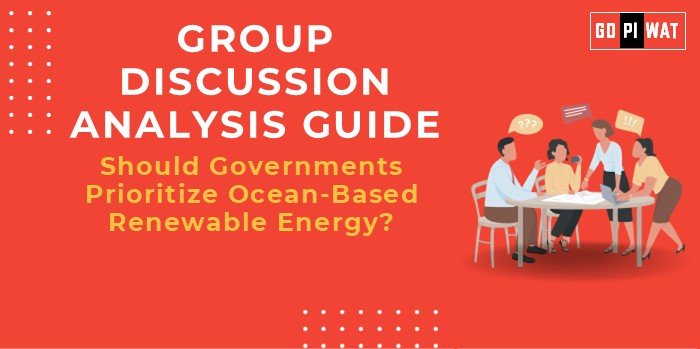📋 Group Discussion Analysis Guide
Should Governments Prioritize Ocean-Based Renewable Energy?
🌊 Introduction to Ocean-Based Renewable Energy
- 🌐 Opening Context: Renewable energy sources like tidal power represent untapped potential in the quest for sustainable alternatives to fossil fuels. With increasing focus on combating climate change, these resources offer a promising path toward energy security and reduced carbon emissions.
- 📖 Topic Background: Ocean energy, including tidal, wave, and ocean thermal energy conversion, harnesses natural forces. While tidal power dates back to the 20th century, innovations have brought it to the forefront. The UK and Canada lead global tidal projects, setting benchmarks for viability.
📊 Quick Facts and Key Statistics
- 🌍 Global Tidal Energy Potential: Estimated at 1,200 TWh/year, enough to power over 100 million homes.
- ⚡ Cost Parity Forecast: Tidal energy could reach fossil fuel parity by 2035 (IEA).
- 🇬🇧 Leading Nations: UK and France account for 80% of installed tidal power capacity.
- ♻️ Global Carbon Emissions: Oceans could offset 5% if fully utilized for energy.
🌍 Stakeholders and Their Roles
- 🏛️ Governments: Offer subsidies and set regulatory frameworks to promote research and deployment.
- 🏢 Private Sector: Innovates and deploys technology for tidal power plants, like Orbital Marine Power’s O2 turbine.
- 📚 Academia and NGOs: Conduct research to improve efficiency and mitigate environmental concerns.
- 👥 Local Communities: Beneficiaries of sustainable energy; provide workforce and local insight.
🏆 Achievements and Challenges
Achievements:
- 💡 Technological Advances: Development of durable turbines like the MeyGen Project in Scotland.
- 🔋 Energy Security: Tidal plants like La Rance in France provide predictable energy.
- 🌍 Environmental Benefits: Reduced dependence on fossil fuels, aiding emissions targets.
Challenges:
- 💸 High Initial Costs: Installation and maintenance costs remain prohibitive.
- 🌊 Environmental Impact: Risks to marine ecosystems from turbines.
- ⚖️ Global Comparisons: While the UK excels, developing nations struggle with funding and expertise.
📖 Case Studies:
- 🇬🇧 MeyGen Project, Scotland: World’s largest tidal energy project, producing 22 GWh annually.
- 🇰🇷 Sihwa Lake Tidal Power Plant, South Korea: Supplies energy to over 50,000 homes.
💬 Structured Arguments for Discussion
- ✅ Supporting Stance: “Tidal energy offers predictable, carbon-neutral energy, crucial for achieving global net-zero targets.”
- ❌ Opposing Stance: “High costs and ecological risks hinder tidal energy’s scalability.”
- ⚖️ Balanced Perspective: “While tidal power shows promise, further innovation and funding are needed to address costs and ecological concerns.”
🗣️ Effective Discussion Approaches
Opening Approaches:
- 📊 “With a potential to offset 5% of global emissions, ocean energy is an untapped powerhouse.”
- 🌊 “Despite its benefits, tidal energy faces cost and ecological challenges.”
Counter-Argument Handling:
- 💡 Rebut high costs by highlighting government subsidies and decreasing costs over time.
- 🌱 Address ecological concerns with examples of eco-friendly installations.
📊 Strategic Analysis of Strengths and Weaknesses
- 💪 Strengths: Renewable, predictable, reduces carbon emissions.
- ❌ Weaknesses: Costly, environmental impact.
- 🌟 Opportunities: Increased investment, technological advancements.
- ⚠️ Threats: Competing renewable sources, regulatory hurdles.
🎓 Connecting with B-School Applications
- 🌐 Real-World Applications: Projects in operations or policy focusing on renewable energy financing or environmental impact studies.
- 🎯 Sample Interview Questions:
- “What factors determine the viability of tidal energy in developing nations?”
- “How does tidal energy compare with solar and wind?”
- 📘 Insights for B-School Students: Renewable energy is an interdisciplinary theme, valuable for exploring finance, technology, and sustainability projects.


